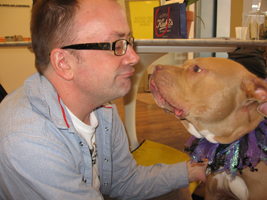Everything You Know about Pit Bulls is Wrong
Ken Foster’s new book aims to change hearts and minds about the much maligned bully breeds
Ken Foster’s first “pit bull,” Brando, was pulled from a New York City shelter in 2001. The shelter identified him as a pit bull simply because he had a brindle coat. The author’s next pit bull arrived on his doorstep in Florida and refused to leave. That was Sula, who prompted Foster to establish the Sula Foundation, a non-profit pit-bull advocacy group based in New Orleans, where he lives. Today Foster’s pack includes Brando, Zephyr, Douglas, and Bananas. Plus Jake, the most recent addition: a sixty-pound mixed breed that Foster’s New York editor found tied to his doorknob after Hurricane Sandy.
 Foster, author of The Dogs Who Found Me and Dogs I Have Met, has some experience with canine refugees. In 2005, he found himself in the wreckage of Hurricane Katrina. New Orleans was nearly deserted by its human population, but lost in the wake of their exodus were hundreds of abandoned pets. A huge number of the dogs were identified as pit bulls. Their desperate, clinging need for human companionship surprised nervous rescuers, who expected them to be vicious killers, and not the terrified family pets Foster insists they are.
Foster, author of The Dogs Who Found Me and Dogs I Have Met, has some experience with canine refugees. In 2005, he found himself in the wreckage of Hurricane Katrina. New Orleans was nearly deserted by its human population, but lost in the wake of their exodus were hundreds of abandoned pets. A huge number of the dogs were identified as pit bulls. Their desperate, clinging need for human companionship surprised nervous rescuers, who expected them to be vicious killers, and not the terrified family pets Foster insists they are.
I’m a Good Dog traces the evolution of a muscular Old World terrier designed for vermin control on English farms to today’s “pit bull,” an array of mixed-breed descendants whose DNA when tested is likely to pop up with as much retriever, or many other breeds, as classic Staffordshire Bull Terrier. For Foster, the defining traits of a pit bull may simply be a blocky head, short hair, athleticism—and a capacity for love and licking that defies the breed’s savage stereotype.
For all pit-bull aficionados, I’m a Good Dog will be a delight. For the haters, it may dispel some of the myths and allay the fears. The author himself compares his love for the breed to that of a pair of famous lovers. “Does the fact that people question our pit bull love make it that much more intense? Possibly — because in the case of Sula, I know that I saved her life, and despite what some people say, saving an animal’s life is never a selfless act; there are huge emotional rewards. Like all forbidden love, from Romeo and Juliet on down the line, each time anyone questions or disapproves of our love, we defiantly love each other even more than before.”
Foster recently answered questions from Chapter 16 via email prior to a book tour which will include stops in both Memphis and Knoxville:
Chapter 16: Has owning, or being owned by, pit bulls changed your thinking about anything?
Foster: I think becoming a dog owner changed me significantly because being a good dog owner requires that you get out of your own head on a regular basis. In most ways, owning a “pit bull” isn’t distinctly different, except that you deal with others’ misperceptions and outright hatred, not just of the breed, but also of anyone who might own one. It certainly makes me feel more compassionate toward anyone who has been judged by appearance or association before being judged as an individual.
Chapter 16: Do Staffordshire Bull Terriers, American Pit Bull Terriers, and American Staffordshire Terriers tend to be at all different in temperament from the broad range of mixed-breed dogs that people think of as pit bulls?
Foster: I think breed enthusiasts may argue the traits of these related breeds, but they all fall in a range of mixed-breed dogs, and even breeding for particular traits is limited in success.
Chapter 16: I’m a Good Dog is a celebration of the pit bull’s capacity for affection. What qualities make them particularly good family pets?
Foster: I think any family getting a dog needs to find the right dog for their specific needs and desires and abilities, but for many people a pit bull is that. Traditionally, they aren’t very large, but they are hearty, athletic, and love to stick by their people: family, friends, neighbors.
 Chapter 16: Unfortunately, many people know these animals only from news accounts of attacks by pit bulls on humans and other dogs. Is their reputation in any way deserved?
Chapter 16: Unfortunately, many people know these animals only from news accounts of attacks by pit bulls on humans and other dogs. Is their reputation in any way deserved?
Foster: No, actually not at all. First, there has been a lot of research that shows conclusively that attacks by other breeds do happen—but are rarely reported in the news. Also, the breed of dogs is frequently misreported as being “pit bull” when they are absolutely not. There are often signs of temperament issues in these dogs that have been ignored or pushed aside, so the idea of a dog attacking without warning is also somewhat mythical. The most important thing, perhaps, is that we live in a country with millions of dogs, yet the incidence of biting remains, in comparison, very, very small.
Chapter 16: Certain breeds—such as German Shepherds, Dobermans, Rottweilers, and bullmastiffs—are more likely to be used in police and guard work. Is that because certain breeds are more temperamentally inclined to ferocity? Because these breeds are more likely to inspire fear in wrongdoers? Something else altogether?
Foster: That’s an interesting question. I imagine it is for the same reasons that petite people are rarely hired in security work. Size is intimidating. The thing with dogs that are used for guard work or protection is that what we, the owner, really want is for the dog to never have a need to protect us. So their image can be a deterrent, just like an ADT alarm sign might keep people from breaking in.
Chapter 16: In I’m a Good Dog you write that the Michael Vick dog-fighting case may have marked a sea change in the way the public views pit bulls by making people understand that these dogs were victims rather than bad actors themselves. Do you think this is a permanent shift?
Foster: I think so. There is a huge difference in the acceptance of the dogs from where they were a few years ago. Of course, there are still too many of them ending up in shelters, which is another part of the problem, but I think there is a broad base of awareness now, even if there is still a lot of room to go. In the past, it was the bloodhound who was viewed as dangerous, and then the German Shepherd, and the Doberman. So, unfortunately, there will likely be another breed that takes the place of the pit bull in being blamed for all that is wrong with dogs and their owners.
Chapter 16: What can/should neighbors do when they observe or suspect animal abuse or neglect?
Foster: I think it’s best to try to open a dialogue with the neighbors involved; often what we think is abuse or neglect is actually just the result of an inexperienced owner who has been given bad advice from a friend. They may welcome your help. But if that’s not the case, report it to the local authorities and keep a record of your communication with them, so you can follow up on what is or isn’t done.
Chapter 16: You write about the negative effects of local bans on pit bulls, or other breeds, in cities like Denver. Why aren’t breed-specific local ordinances a good idea?
Foster: The short answer is that they don’t work. There aren’t any cities or countries that have found success in banning a particular breed. But it also is a law that looks at the wrong factors in public safety: dog bites are reduced by having laws that address owner responsibility and individual dog behavior—and enforcing those laws.
Chapter 16: What can pit bull owners do to make sure their dogs are good citizens and good ambassadors for the breed?
Foster: We always want to show our dogs off in the best light, but we need to also realize that dogs are individuals with individual thresholds, so we need to not push them into situations that they may not feel comfortable in. For example, some dogs are great at dog parks, but for others it is the last place they want to be. A basic starting point, for new dogs, is to train them for basic “manners” first—walking on a leash, sitting when told, properly greeting strangers, etc. And some people may want to consider training for agility or therapy work. But our dogs don’t need to be show-offs; they can also represent by just showing themselves to be regular dogs.
Ken Foster will discuss I’m a Good Dog at The Booksellers at Laurelwood in Memphis on January 24 at 6 p.m., and at Union Ave. Books in Knoxville on January 26 at 2 p.m.





